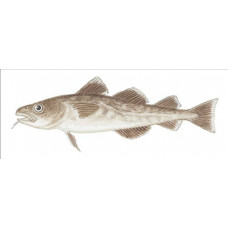Latin name
Gadus macrocephalus
Other names
Сod, gray cod, true cod; French: morue du Pacifique; Italian: merluzzo del Pacifico; Japanese: madara; Portuguese: bacalhau-doPacifico; Spanish: bacalao del Pacifico.
Identification
The Pacific cod, characteristic of the cod family, has three distinct dorsal fins, two anal fins, and one large barb under the chin. The body is heavy and elongated, with fine scales, a large mouth, and soft rays. Coloration is gray to brown on the back, lighter on the sides and belly. Numerous brown spots cover the sides and back. All fins are dark, and unpaired fins have white edging along the outer edge. Pacific cod can be distinguished from Atlantic cod, which is almost identical to it, by its smaller body and sharper fins.
Distribution
Pacific cod inhabit waters along the U.S. Pacific coast from Santa Monica, California, to northwestern Alaska. It is common in the northwestern waters of Oregon, Washington, and Alaska. North Pacific and adjacent seas off the coasts of Asia and North America, from the Bering Strait to the Yellow Sea in the west and to Los Angeles in the east.
Habitat
A marine, gregarious fish. Most often lives on the bottom, but during the spawning period and during feeding, moves into the water column to a depth of 800 feet. Prefers rocky, gravel or sandy bottoms in cold water.
Size
The average size is less than 3 feet, weighing 15 pounds or smaller. The record is 30 pounds. Pacific cod grows more slowly in the south than in the north. It reaches sexual maturity at 5-6 years of age.
Life history and Behavior
The diameter of the eggs varies from 0.8 to 1.35 mm. The eggs are bottom-dwelling, almost transparent, without fat droplets, and slightly sticky. The development of eggs lasts from 9 to 20 days. The newly hatched larvae are 3.6-4 mm long. After 10 days, with a length of 5 to 9 mm, the dissolution of the yolk sac is completed. At 5-6 months after hatching, the fry are 8 to 26 cm long.
Food and feeding habits
Pacific cod are omnivores. Young cod feed mainly on small benthic crustaceans and worms. Adults feed on dominant food organisms, especially herring, capelin, sand eels, sardines, mint, and other cod species. Its behavior is similar to that of Atlantic cod.
Reproduction
Spawning is one-time, occurs in the near-bottom horizons. In the Gulf of Alaska, the Aleutian Islands, and the Commander Islands, spawning occurs from March to May. Off the coast of Japan and Korea, from December to February in shallow waters at bottom temperatures of 5-9°С. Fertility ranges from 1400 to, 6400 thousand eggs.
| Classification | |
| Phylum | Chordata |
| Class | Actinopterygii |
| Squad | Gadiformes |
| Family | Gadidae |
| Genus | Gadus |
| Species | G.macrocephalus |
| Features | |
| Conservation status | No information |
| Habitat | Pelagic |
| Life span, years | 12 |
| Maximum body weight, kg | 22.7 |
| Maximum length, cm | 120 |
| Sailing speed, m/s | No information |
| Threat to people | Edible |
| Way of eating | predator |



